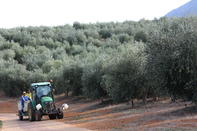South Africa produces high quality, but relatively low volumes of olive oil, barely enough to satisfy a third of local demand. Yet, South Africa manages to export olive oil, mainly to African countries such as Namibia (about 300 tonnes) and Botswana (200 tonnes), but also 50 tonnes to the UK (2017 figures).

Olive Oil Production Areas
According to a Hortgro report, 2 849 ha of olives are planted in South Africa. This constitutes an increase of 110% in plantings over ten years from 2008 when only 1 357 ha were planted. The biggest growth in plantings has been in the Cape Town district, where new plantings have increased by 640% - from 56 hectares in 2012 to 414 hectares in 2018.
The production of olive oil in South Africa is focused in the Western Cape with 93%, while other provinces, except KwaZulu-Natal, contribute between 1% and 3% each to South Africa’s total olive oil production.
In 2018, there were just over 170 registered olive growers in South Africa. Around half of these were farming on less than 5 ha. Yet, the 11 largest growers were farming more than 50 hectares each. These producers produce, in total, 44% of South Africa’s plantings.
The olive harvest in South Africa takes place between March and June/July. Oils are extracted and by August/September the year’s harvest of fresh olive oil is available.
World Production of Olive Oil
The world’s main producers of olive oil are countries around the Mediterranean and in the Middle East. Among the top-ten countries are Spain, Italy, Greece, Turkey, Syria, Tunisia, Morocco, Algeria and Portugal.
Global olive oil production is estimated to decrease by 5.5 % to 3.130 million tons in the 2018/19 harvest season, according to the International Olive Council (IOC). Countries that experienced a large decrease of more than 50% of their production were Tunisia and Argentina.
Other countries that experienced major declines in production include Greece by 35%, and Turkey by 30%. In Italy, bad weather damaged 25 million trees, which led to a 38% decrease in production. Despite this, Italy remains the second-largest producer of olive oil, after Spain.
The world's biggest importer of olive oil is the USA, importing between 35% and 40% of world production yet the country has a low capita consumption of only 1.3 litre/person per year.
The world’s biggest consumers are the Greeks, 20 litres/person per year, Spaniards 13 litres and Italians 11 litres.
Olive Oil Imports
According to Hortgro’s statistics, South Africa imported about 6 900 tonnes of olive oil in 2017. Around 70% was from Spain and 19% from Italy. Imports from Argentina seem to be increasing from 2015, but still only contribute 2% of the total olive oil imports into South Africa.
By Marinda Louw